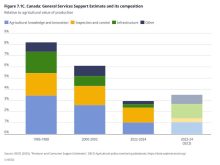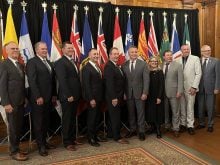Farmers who vote Liberal or NDP are far more likely to think the federal fertilizer emissions reduction target is feasible than farmers who vote Conservative, a recent survey indicates.
That meant the majority of survey respondents were pessimistic about the government’s goals, as 77 per cent said they’d vote Conservative.
In an Aug. 29 survey, research firm iFusion quantified farmers’ feelings on the federal goal to reduce emissions from fertilizer by 30 per cent by 2030.
Read Also

New ranking elevates Assiniboine College to national research elite
Brandon’s Assiniboine College is 47th in a national ranking measuring research dollars and output at publicly funded institutions in Canada.
About 550 farmers from the Prairie provinces completed the phone survey.
No organization commissioned the survey, iFusion president Greg Dunlop told the Co-operator in an email.
“I was personally interested to quantify the concerns I had seen anecdotally in the farm press and elsewhere,” Dunlop said.
The firm used the data to inform a submission to the federal government on the emissions matter.
Of all farmers surveyed, 83 per cent said they disagreed with the federal government’s goal.
More than 90 per cent of farmers who said they voted Conservative also said they somewhat or strongly disagreed with the target. Among Liberal and NDP voters (this category was combined), nearly 70 per cent either somewhat or strongly agreed.
There was no significant difference in opinion between provinces.
More than half of all farmers surveyed believe that fertilizer emission estimates ignore actual farm practices, while nearly a third did not know.
Current emissions estimates, taken from Canada’s National Inventory Report (NIR) take variation in climate and topography into account, along with fertilizer sales data. Efforts to incorporate management practices into the algorithm are under way but will take years, University of Manitoba researcher Mario Tenuta told the Co-operator.
Farmers surveyed were told about 4R nutrient stewardship — a framework of best management practices for efficient fertilizer use.
To hear the full ‘Between the Rows’ podcast episode, click here.
They were then asked if federal targets could be met with 4Rs were taken into account. Fifty-seven per cent still said the goal was not achievable, but the number of respondents who said the goal was achievable or very achievable rose to 26 per cent from 10 per cent.
Half of the farmers surveyed said they were familiar with the 4R nutrient stewardship program.
Most farmers did not trust the federal government to keep its emissions target voluntary. Over 70 per cent said the government would force mandates such as caps on fertilizer use if sufficient progress wasn’t made in the next three years.
About 20 per cent said they were not sure, and six per cent said it would remain voluntary.
















